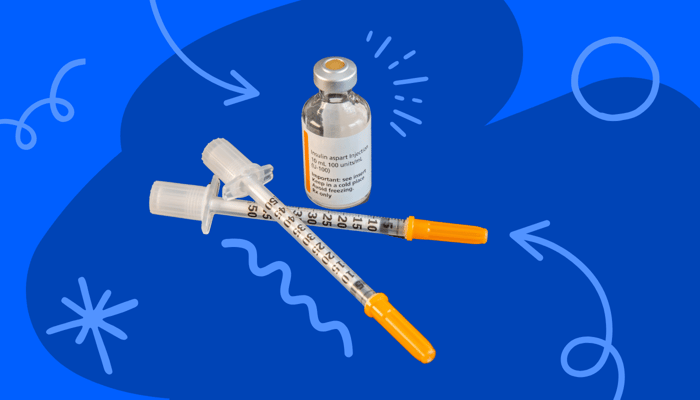Table of Contents
Key Takeaways
You can monitor blood sugar at home with over-the-counter (OTC) fingerstick meters, certain continuous glucose monitors (CGMs), or home A1C tests.
Fingerstick meters are accessible and portable, while CGMs provide round-the-clock glucose tracking.
Some CGMs and supplies still require a prescription, especially if you want insurance coverage.
Tracking blood sugar levels is no longer just for people with diabetes. Many people are interested in learning how to monitor blood sugar for personal health reasons. They might want to catch early changes, adjust their habits, or just get a sense of how their body reacts to food and exercise.
You can typically find fingerstick glucose meters and test strips at most pharmacies—no hoops to jump through. There are even some CGMs you can grab over the counter. With the potential choices in mind, you can take charge of your own glucose monitoring at home.
Types of Blood Sugar Tests You Can Get Without a Prescription
You have different options if you want to monitor blood sugar at home without a prescription. These options can vary in how they’re used and what they’re used for.
Blood glucose meters
OTC blood glucose meters are probably the most common. These pocket-sized devices use a finger prick to test a tiny drop of blood. They can show your glucose level in seconds.
These blood sugar meters are accessible and easy to carry around. The catch? You only get a single reading at a time, so you won’t see how things change over the day unless you test a lot. Still, they’re useful and a common household item for people with diabetes.
Blood glucose meters you may be able to get without a prescription include:
-
TRUE METRIX Self Monitoring Blood Glucose Meter

$ 30.89
$ 38.61The TRUE METRIX Self Monitoring Glucose Meter by Trividia Health is a reliable monitor for quick and accurate blood glucose testing. The TRUE METRIX self monitoring meter tests blood sugar from the fingertip or forearm, and is able to store 500… read more
Certain CGMs
Continuous glucose monitors are small sensors you wear, usually on your arm or belly, that keep tabs on your glucose in the fluid under your skin. Depending on where you live, some models don’t need a prescription.
CGMs give you round-the-clock readings and make it simple to monitor blood sugar throughout the day. They’re a bit pricier than basic meters, though, and you have to swap out the sensor every week or two. Lingo (by Abbot) and Stelo (by Dexcom) are common OTC CGMs.
CGMs that may require a prescription include:
-
Dexcom G7 CGM System

$ 161.99
$ 205.99The Dexcom G7 Continuous Glucose Monitoring System (CGM) is a comprehensive system that has changed the way individuals living with diabetes have monitored and maintained their blood glucose levels. Dexcom G7 is for patients two years and older with any type… read more
-
FreeStyle Libre 3 Plus Sensor

$ 129.77
$ 162.21FreeStyle Libre 3 Plus iCGM Sensor Kit Features: ACCURATE. The most accurate iCGM system to help reduce time spent in hypoglycemia*3 and improve overall glucose control*3,4. Extended sensor for up to 15 days. DISCREET. The world’s smallest?2, thinnestII, _ smaller than… read more
Home A1C tests
Home A1C test kits tell you your average blood sugar over the last three months. You can pick them up online or at most pharmacies, no prescription needed. These are better for seeing the big picture but not the best way to monitor blood sugar day to day.
Many pharmacy or lab walk-in tests let you come in for a quick fingerstick or A1C test without a prescription or appointment. Big pharmacy chains usually offer this, and you’ll often get results in just a few minutes.
Common at-home A1C tests without a prescription include:
-
A1CNow® Self Check - 4 Count Test Kit

$ 54.99
$ 109.19A1C is a window into your overall blood glucose control, spanning the past two to three months. The A1CNow® Self Check system provides a quick and easy way to get accurate HbA1C results at home that you can use to… read more
-
TRUEplus A1CNow Self Check Test System - 2 Count Test Kit

$ 39.99
$ 57.99TRUE+A1CNowTM Self Check Test System Features: Results in 5 minutes Small (5 µL) fingerstick blood sample No maintenance Room temperature storage Small, compact, and battery powered Affordable and easy to use Includes A1CNowTM Self Check Analyzer 2 Cartridge Pouches 2… read more
Even if you’re able to get your hands on a diabetes test without a prescription, you’ll want to keep the costs in mind and ask your healthcare provider for advice.
How to choose the right option for you
Whether you want to monitor blood sugar periodically or continuously throughout the day, you won’t have trouble finding what you’re looking for.
However, you may want to think about these factors when choosing the right option:
How often do you want to check your blood sugar? If you only check your blood sugar once in a while, a fingerstick meter is probably all you need. But if you’re testing several times a day, a CGM might be worth the investment. It just depends on your budget and what you’re comfortable with.
Are you comfortable with finger pricks? Some people really don’t like finger pricks, while others can’t stand the idea of wearing a sensor. There’s no one-size-fits-all answer here.
What kind of information would help you more? A basic meter gives you a number right away. A CGM lets you see patterns and trends, which can be helpful if you’re trying to make sense of what’s going on.
Before you decide, compare prices, see what’s actually available near you, and ask yourself which option fits your life (and your goals) best.
When to See a Doctor
If you want your blood sugar supplies covered by insurance, you’ll probably need a prescription from a doctor. That’s true even for some meters and supplies you can buy off the shelf. Seeing a doctor or healthcare provider can also help if you’ve got your eye on a specific CGM that isn’t sold over the counter.
You should also see a healthcare provider if you’re having any symptoms that could point to diabetes, such as:
Extreme thirst
Frequent urination
Blurry vision
Unexplained fatigue
Even if you can buy a device without a prescription, your healthcare provider can help confirm whether your readings are accurate, rule out any serious health problems, and recommend the best device for your needs. Catching problems early can make treatment simpler and help you avoid future problems.
Bottom Line
You can grab a fingerstick glucose meter at just about any pharmacy, big-box store, or online store—no prescription needed. These meters work with small, disposable test strips and just a drop of blood from your fingertip. Some continuous glucose monitors still make you get a prescription from your doctor, especially if they come with extras like alerts for high or low readings.
If you’re managing prediabetes or just looking to monitor blood sugar more closely, chatting with your doctor about which device to use is recommended. It can help you stay safe and get the most accurate info.
Sources
Blood Glucose Monitoring Devices, U.S. Food and Drug Administration (2024)
FDA Clears First Over-the-Counter Continuous Glucose Monitor, U.S. Food and Drug Administration (2024)
Hemoglobin A1C (HbA1c) Test, MedlinePlus (2025)
Symptoms, Diagnosis and Monitoring of Diabetes, American Heart Association (2024)
FAQs
Do I need a prescription to monitor blood sugar?
You can typically find fingerstick glucose meters and test strips at most pharmacies—no hoops to jump through. There are even some CGMs you can grab over the counter. Some CGMs (continuous glucose monitors) and supplies still require a prescription, especially if you want insurance coverage. Depending on where you live, some models don't need a prescription. Always consult your local and state guidelines.
Which home diabetes test should I use?
How often do you want to check your blood sugar? If you only check your blood sugar once in a while, a fingerstick blood glucose meter is probably all you need. But if you’re testing several times a day, a CGM (continuous glucose monitor) might be worth the investment. It just depends on your budget and what you’re comfortable with.
What is a blood glucose meter?
Blood glucose meters are pocket-sized devices that use a finger prick to test a tiny drop of blood. They can show your glucose level in seconds. The catch? You only get a single reading at a time, so you won’t see how things change over the day unless you test a lot.
What is a CGM?
CGM stands for continuous glucose monitor. CGMs give you round-the-clock readings and make it simple to monitor blood sugar throughout the day. They’re a bit pricier than basic meters, though, and you have to swap out the sensor every week or two.












